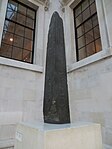Secretum (British Museum)
Collection of the British MuseumMuseums in popular cultureSex museumsSexuality in classical antiquitySexuality in the United Kingdom ... and 3 more
Sexuality stubsUnited Kingdom museum stubsUse British English from August 2015

The Secretum or secret museum was a section of the British Museum created officially in 1865 to store all historical items deemed to be obscene.
Excerpt from the Wikipedia article Secretum (British Museum) (License: CC BY-SA 3.0, Authors, Images).Secretum (British Museum)
Great Court, London Bloomsbury (London Borough of Camden)
Geographical coordinates (GPS) Address Nearby Places Show on map
Geographical coordinates (GPS)
| Latitude | Longitude |
|---|---|
| N 51.519 ° | E -0.127 ° |
Address
Reading Room
Great Court
WC1B 3DE London, Bloomsbury (London Borough of Camden)
England, United Kingdom
Open on Google Maps









